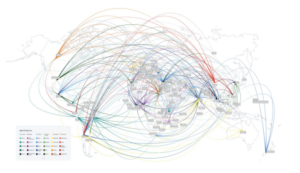Most brands collect customer data by directly asking for it through registration or subscription forms during the initial interaction with customers.
Websites are now equipped with cookies that enable brands to track their visitor’s browsing histories, even as they exit the site and browse other things on the web.
Email tracking allows brands to learn that a recipient has opened a mail, where it was opened and on what device. Apps have a similar tracking feature.

We live in a time where technology has become multi-fold in almost every sector. The technology generates data that can yield valuable insights about the field and can help companies form a roadmap to drive growth and development. Data analytics helps marketers to get precise customer insights, from their employment status to their content consumption habits.
By gathering substantial amounts of data, marketers explore the trends and patterns of customers to build successful campaigns around it and engage in data-driven marketing. Data-driven marketing is the strategy of using customer information for optimal and targeted media buying and creative messaging. It is taking the answers to questions like when, where, and what message and making those answers actionable.
Usage and activation of data allow a significantly more optimised media and creative strategy. This people-first strategy is more personalized is responsible for driving considerable ROIs in the market today
How Brands Obtain Data Analytics:
In this day and age of constant connectivity and the Internet of Things, consumer data is being collected round the clock by companies and brands. Computers today can identify your voice, recognize your face, trace your internet browsing history through cookie technology, identify your location through GPS, and record your digital transactions payments. This information helps brands build accurate consumer profiles, and predict their preferences and spending behaviour. The ways in which brands collect this data:
- Most brands collect customer data by directly asking for it through registration or subscription forms during the initial interaction with customers. Basic details such as name, age, gender and email address are collected through these forms.
- Through Website Cookies: Most websites are now equipped with cookies that enable brands to track their visitor’s browsing histories, even as they exit the site and browse other things on the web.
- Email tracking and Apps: Email tracking allows brands to learn that a recipient has opened a mail, where it was opened and on what device. Apps have a similar tracking feature.
Predicting Consumer Behaviour To Drive Sales
Tapping into consumer behaviour is imperative to increase sales and improve customer retention. Data analysis shows how many people click on your website and predict if they’ll be back. Companies can use this to calculate customer value and adopt a proactive retention approach to retain customers.
This model has been successfully implemented by Zara. The company tracks, analyses and calculates its sales through customer surveys and RFID tags, and gets feedback about public opinion. Based on this, Zara has enabled better inventory management, design and distribution. Today, Zara sells over 11,000 new designs each year as opposed to 4000 designs sold by its rivals.
Place Products In Accordance With Customer Behaviour And Motivation
To get a clear understanding of your audience as it relates to your campaign, study their behaviour and motivation. The behaviours that are of interest to you depend on your marketing goals. For instance, you can study the channel your audience is most likely to use and use it to optimize your content. If your audience is using Instagram, make sure that you have a larger presence there and run relevant advertisements for your audience.
Similarly, understanding the motivation of your audience can help you figure out how to appeal to them. It enables you to offer something that empowers them to achieve their goals while accomplishing your goals too. For example, if you’re a B2B marketer, your customers’ motivations likely include growing their business. Use this information to present your product in a way that highlights its ability to get them new clients.
Customer Segmentation
Data Analytics can help marketers segment their customers based on shared qualities or characteristics. By grouping customers into segments, brands can make certain assumptions about what they value most and take the approach that is most likely to resonate with them. Customers can be segmented on the following basis:
- Demographic Segmentation
- Psychographic Segmentation
- Behavioural Segmentation
- Geographic Segmentation
For example, if a brand deals with the sale of cars, then information on gender, income, age and family size of the prospective customers can help marketers reach them easily. Customers with a larger family size are less likely to buy an expensive car than a young professional with a high income and family size of 1.
Use Advertising Data to optimize marketing channels:
Using data from paid advertising campaigns, marketers can create and implement their strategies according to which channels leads are coming from to optimize conversion rates. Brands can identify which channels perform the best and evoke the desired behaviour and plan their content accordingly. They can also gain insights on customers, identify the most profitable keywords and set up relevant SEO campaigns.
Brands can also identify which content format works best for them, be it email, blog posts or social media.
Look-Alike Targeting
Data Analytics helps companies identify who their best customers are in order to find high-value prospects that are similar to them. Once your company or brand has a considerable amount of customers, you should identify the most engaged customers who are profitable. Identify their attributes and use that information to attract similar customers.
Knowing who your best customers are- their attitudes and purchase patterns will enable you to predict the types of messages they will best respond to and the best channels to engage with them. This will help you narrow your targeting approach and focus on successful leads.
In today’s technology-driven world, predictive analysis is an important investment for growing your business. Implementing big data analytics can help brands achieve a competitive edge over others, reduce marketing costs and drive customer retention. While data is becoming readily available to all organsations, companies need to ensure that they implement appropriate data analysis systems and make use of them to build effective marketing campaigns.








